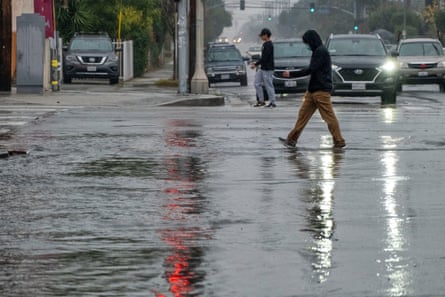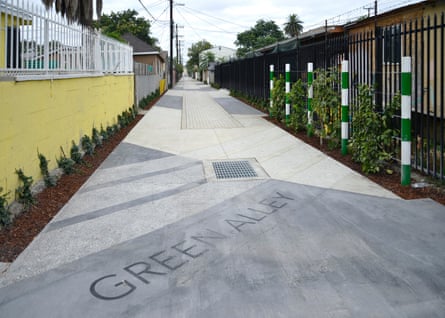The parched metropolis: can eco architecture save LA from megadrought? | Architecture
[ad_1]
After weeks of record-breaking rainfall have seen freeways flood, hillsides collapse and the dry concrete gutter of the Los Angeles River transform into a raging torrent, you may have assumed that California’s water-shortage woes were beginning to ease. With many areas receiving their usual annual rainfall in just three weeks, surely the multiyear megadrought is finally abating.
Sadly, no. Decades of building concrete gutters – driven by the mindset that stormwater is a threat to be banished, not an asset to be stored – have meant that the vast majority of that rain was simply flushed out into the ocean. Of the billions of gallons that have fallen on the LA area, only a tiny fraction were absorbed into the ground.
Pumping water into LA is the biggest use of electricity in the state
“Our cities are literally designed to get rid of the most precious resource we have as quickly as possible,” says Bruce Reznik, director of LA Waterkeeper, a non-profit organisation that fights for sustainable water management. “We spend billions of dollars to pave over paradise, then we realise we have flooding problems. So we spend billions more to build concrete channels to get the water away from us. Then we realise we have a water supply problem, so we spend billions more to pump water in from elsewhere – which is also the biggest use of electricity in the state. It’s insane and not sustainable.”
All that, Reznik might add, while stealing as much as it can from elsewhere: LA County imports almost 60% of its water from thousands of miles away, via open-air aqueducts, siphoning it off from lakes and rivers to the north which are now drying up as a result of the demand, causing ecological havoc. At the same time, LA County pumps 500m gallons of highly treated wastewater out into the Pacific Ocean every day, along with 100m gallons of runoff from the streets. Every year, more than enough water to fulfil the city’s needs is simply flushed into a superhighway that carries it out to sea. With mountain snowpack thinning out and lakes ever shrinking, can this most impervious of urban landscapes adapt? Can it find a way to harvest and store its most precious life source?

In an unremarkable corner of East LA, once known for its fields of flowers and fruit but long since trampled by suburban sprawl, one of the first signs of a more permeable future is now visible. Where barren strips of sun-scorched grass and drought-stricken trees used to stretch down the middle of two long streets, a pair of lush, stormwater-capturing gardens now sprout. Ditches of pebbles snake their way between winding footpaths, lined with fragrant, drought-tolerant plants. Yellow tiger swallowtail butterflies flit between gold and purple lantana flowers while a cat creeps around the foxtail agave and coyote brush, beneath the fiery red blooms of coral aloe. Picnic benches and exercise equipment dot the clearings, shaded by jacaranda, Chinese elm and California sycamore. But the most important innovation is hidden below ground.
More than 100 “drywells” have been drilled beneath these strips, designed to receive water from a nearby storm drain which would otherwise flush out into the ocean, and slowly spread it back into the ground. A pretreatment system filters out trash, oil and sediment before distributing the water to the 30-metre deep wells, where it is further filtered through rocks and sand, then released into the aquifer, the layer where groundwater is held. Meanwhile, the ditches (or bioswales) capture and filter runoff from the streets. During a single January storm, the county says, this project collected around 16m gallons of water. More than 98m gallons are expected to be captured here annually – enough to supply 600 families. Not bad for a strip of greenery.
Private property owners are now charged 2.5 cents per square foot of impermeable surface area on their land
“It has transformed the neighbourhood,” says one dog-walker, pausing by a plaque that explains how the groundwater recharge system works. “We have two beautiful new parks, but they’re also doing a job we so desperately need.”
The $37m scheme is one of the first completed projects to receive funding from the Safe Clean Water programme, a county-wide initiative funded by Measure W, a stormwater tax that residents voted for in 2018. Following a “polluter pays” principle, private property owners are now charged 2.5 cents per square foot of impermeable surface area on their land. So if you cover your back yard with concrete, you’ll be walloped. It may sound like a token gesture but the tax has already generated $1bn and funded more than 100 schemes.

“The focus is on multibenefit projects,” says Reznik, who chairs the committee that assesses requests for funding. “Not only capturing water but greening local communities, reducing flood risk, promoting carbon sequestration, reducing the heat-island effect, and improving access to rivers, lakes and streams.”
He highlights a plan for an urban orchard in South Gate, led by the non-profit Trust for Public Land, on a site sandwiched between a freeway and the LA River. Here, seven acres of polluted brownfield land, surrounded by pylons, truck yards and industry, are being transformed into a sylvan oasis complete with a nursery to breed rare native fish. Along with a stormwater treatment and groundwater recharge system, the park, designed by Studio MLA, will feature a recirculating stream to rear rainbow trout and arroyo chubs, as well as a plaza shaded by 300 oaks, cottonwoods, sycamores and fruit trees.
Get a dose of creative inspiration. Expect original, sustainable ideas and reflection from designers and crafters, along with clever, beautiful products for smarter living
after newsletter promotion
To the north, in Sun Valley, a similar, seemingly unpromising landfill site is being turned into a wetlands park, with a 21-acre “detention pond” for stormwater runoff. The captured rain will then enter a 10-acre wetland, which acts as a natural treatment system, removing pollutants before it’s pumped into infiltration basins to recharge groundwater, with basketball and tennis courts also planned. Other projects include “green alleys”, which have seen concrete passages transformed with permeable pavements, planting and groundwater drains. There are also schemes to green schoolyards, with a focus on areas where access to parks is chronically lacking.
However, some concerns have been raised about how and where the projects are distributed. “One problem is that there isn’t a masterplan,” says Stephanie Pincetl, professor at the UCLA Institute of the Environment and Sustainability, whose students have been assessing the allocation of Measure W funds. “There is no overall assessment of where groundwater infiltration is the most desirable, or hydrologically possible. It’s more a process of the county saying, ‘If you have a project, why don’t you come and see us?’”

The fact that the programme relies on individual bids, rather than an overarching plan, means its success comes down to the capacity and proficiency of the local agencies and non-profits involved. There’s also a dire need for a bigger culture shift: while one city agency might be busy digging progressive bioswales, another is covering sidewalks with yet more concrete.
These new eco landscapes also have to deal with the public perception of what a healthy park should look like. “You have to take into account people’s aesthetics,” says Pincetl. “If you have a wetland that’s dry most of the time, as it will be in LA, is it going to be considered an eyesore?” One landscape architect mentioned visiting a new stormwater retention project last summer, only to find that local residents had ripped out all the plants, assuming the withered, dry specimens were dead. Elsewhere, bioswales have been filled with trash and left clogged, due to lack of maintenance. There is a danger that a big chunk of Measure W cash will ultimately be spent on upkeep.
Zooming out, others see a pressing need for these issues to become an integral part in the training of those who shape the city. “Water has been almost completely absent from architectural education,” says Hadley Arnold, co-founder of the Arid Lands Institute, which was established 20 years ago. “What would it look like if buildings and neighbourhoods were designed to catch, clean and store water, rather than shed it? What if we celebrated this infrastructure and made it visible, rather than burying it all? We need to rethink how our cities are made – every surface can be an opportunity to get water into the ground.”
[ad_2]
Shared From Source link Arts